No summer is complete without a few long, lazy afternoons spent grilling on the patio or in the back yard. It's not exactly rocket science — heating food over a flame goes back a long, long way — but like any other form of cooking, there are definitely ways to improve your grilling game. Here are a few of our favorites.
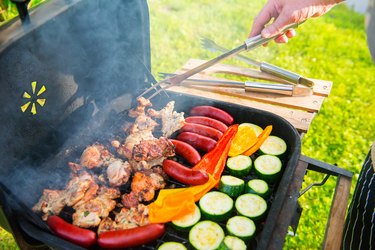
1. Soak Your Skewers
Some grilling enthusiasts invest in a set of heavy-duty steel skewers for their grill, but most of us are happy to make do with the inexpensive disposable wooden or bamboo variety. The only problem is that these are both flammable, and they're going to go directly onto a source of open flame. Before you make up your kebabs, prepare for this by soaking your skewers in cold water for 20 or 30 minutes. They'll be wet enough to resist burning, and won't fall apart when you try to lift them from the grill.
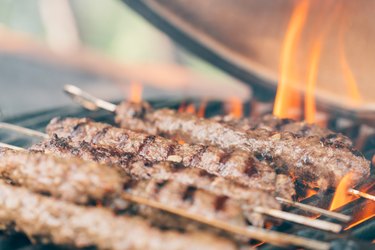 Soaking your skewers in water for 20 to 30 minutes will keep them from igniting. Image Credit: Hugo Goudswaard/Photodisc/GettyImages
Soaking your skewers in water for 20 to 30 minutes will keep them from igniting. Image Credit: Hugo Goudswaard/Photodisc/GettyImages
2. Clean Your Grill With an Onion
The traditional way to clean your grill before (or after) each use is with a wire brush. Unfortunately those get dirty themselves, and can be downright hazardous if the wire bristles detach and find their way into your food. Just cut an onion in half, and rub it vigorously across the grate with your hand or (if it's still hot) a set of tongs or a cloth. The onion's moisture and acidity will help cut through the stuck-on gunk, and leave behind a mild hint of onion flavor for the foods you grill.
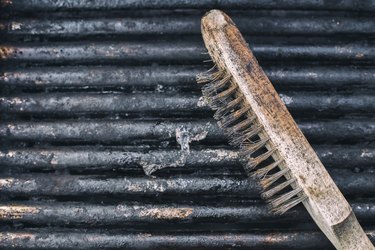 Instead of the dirty and dangerous wire brush, clean your grill with an onion. Image Credit: Stefka Pavlova/Moment/GettyImages
Instead of the dirty and dangerous wire brush, clean your grill with an onion. Image Credit: Stefka Pavlova/Moment/GettyImages
3. Spiral Cut Your Hot Dogs
There's nothing wrong with a plain hot dog, it's just kind of…plain. Before you start piling on the toppings, though, there's a way to make them more special even before they hit the grill: Giving them a spiral cut. The dogs will expand into a long corkscrew shape as they grill, making them look bigger and creating extra space for your condiments and toppings. You can buy dog-cutting gizmos at the department store, or just thread one onto a skewer and then rotate the skewer as you cut it into a spiral with your paring knife.
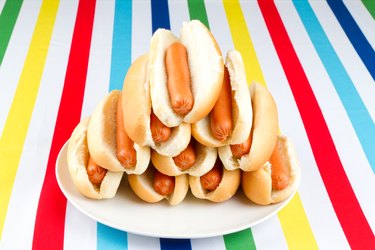 Why settle for plain? Spiral-cutting your hot dogs makes them special. Image Credit: ncognet0/E+/GettyImages
Why settle for plain? Spiral-cutting your hot dogs makes them special. Image Credit: ncognet0/E+/GettyImages
4. Skewer Meat and Veggies Separately
Kebabs made with bright, colorful veggies threaded between the cubes of meat are appealing to the eye, but they often disappoint on the plate. Many vegetables take longer to cook than your meat does, so you'll have to choose between under-cooked vegetables or over-cooked meats. Instead, create separate skewers of meat and vegetables, so you can cook them separately until they're done. They'll still look beautiful once they're paired on a plate, and they'll taste better.
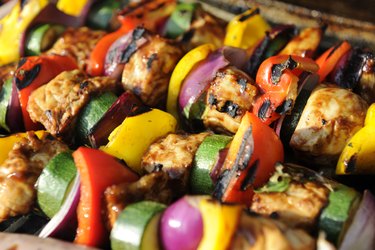 These skewers are pretty, but cooking the meat and veggies separately is more practical. Image Credit: OwenPrice/E+/GettyImages
These skewers are pretty, but cooking the meat and veggies separately is more practical. Image Credit: OwenPrice/E+/GettyImages
5. Master Indirect Heat
Grills are often marketed on how much heat they generate, but you don't necessarily want to apply that heat directly. Serious grill masters often use indirect or "two zone" cooking to get the result they want. In a charcoal grill that means mounding the coals on one side, and on a gas grill it means lighting one side but not the other. Placing your meat over the unheated side and closing the lid creates a gentle cooking environment that's ideal for ribs or a pork butt, or for cooking a thick steak without burning the outside. Then, once it's almost done, transfer it to the hot side for a quick sear (and a splash of barbecue sauce, if that's how you roll).
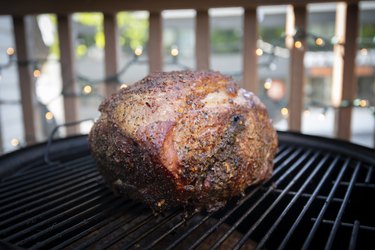 Learning to use indirect heat is an important step toward "grill master" status. Image Credit: Robert Lowdon/Moment/GettyImages
Learning to use indirect heat is an important step toward "grill master" status. Image Credit: Robert Lowdon/Moment/GettyImages
6. Turn Your Grill Into a Smoker
One of the best things about mastering indirect heat on your grill is that you can use that skill to turn your grill into a smoker. Set up for indirect cooking as you normally would, but before you put your meat on the grate place some hardwood pieces into a smoker box or foil pouch, and place it at the edge of the flame or coals. Load the cool side of the grill with your meats, close the lid, and then wait while the smoke infuses your foods with flavor. Even a few minutes will make a difference on a steak, chop, or piece of fish, though pulled pork or brisket takes hours of low-temperature cooking.
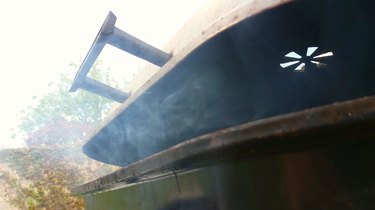 Any grill can be a smoker, once you’ve mastered the necessary skills. Image Credit: mikroman6/Moment/GettyImages
Any grill can be a smoker, once you’ve mastered the necessary skills. Image Credit: mikroman6/Moment/GettyImages
7. Par-Cook Your Meats When Appropriate
Burgers and chops grill pretty quickly, but ribs and larger cuts like a pork butt or whole bird may take longer than you'd like, especially when it's too hot to hover over the grill. You can shorten your cooking time by starting your "cook" indoors in the oven, a toaster oven or slow cooker (don't boil them, which leaches flavor from the meat). Sausages are a notable exception to the rule about wet cooking: Poaching them gently, then finishing them on the grill, is the best way to keep them juicy and flavorful.
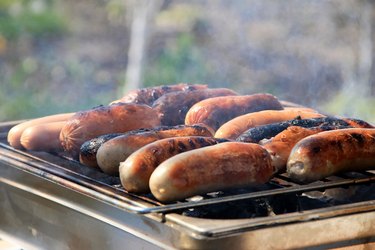 Poaching sausages before finishing them on the grill keeps them juicy and moist. Image Credit: Yulia Naumenko/Moment/GettyImages
Poaching sausages before finishing them on the grill keeps them juicy and moist. Image Credit: Yulia Naumenko/Moment/GettyImages
8. Improvise a Warming Rack
Many grills, especially gas grills, include a heating rack above the main grate. It's a handy place to keep cooked foods warm until you're ready to serve, and it's also a good spot to pre-warm your hot dog or burger buns. If your grill didn't include one, don't sweat it: It's easy to DIY your own. Just find a wire cooling rack that's smaller than your grill, and balance it on top of a few empty cans from your pantry or your beverage of choice. If you'd rather have something a bit less visibly improvised, you can buy add-on warming racks with fold-down feet from online and physical retailers.
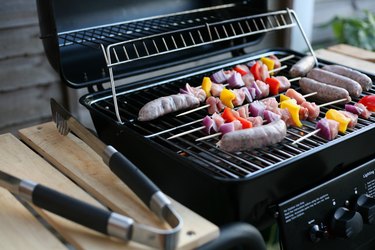 If your grill didn’t come with a warming rack, you can easily improvise one. Image Credit: Nicholas Free/E+/GettyImages
If your grill didn’t come with a warming rack, you can easily improvise one. Image Credit: Nicholas Free/E+/GettyImages
9. Grill Your Fish on Citrus Slices
Squeezing lemon or lime over a grilled fish is traditional, but there's a lot to be said for grilling fish on citrus slices as well. Fish is naturally delicate, and has the nasty habit of breaking up or sticking to the grates when you try to turn it. When you cook it on top of the citrus slices, fish won't stick to the grates, and as a result it's much easier to turn. It also gets infused with those beautiful citrus flavors, lightly perfumed with smoke. As a bonus, the grilled lemon or lime slices make a great garnish for the finished dish.
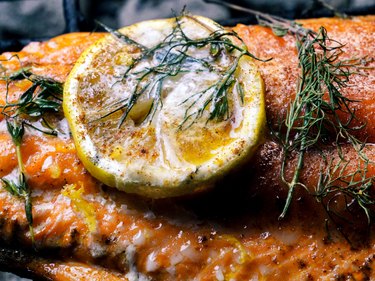
10. Use Bread to Master Your Grill's Hot Spots
It's no secret that every grill cooks differently. Mastering the peculiarities of your own grill is an important step in getting the results you want, every time, and a plain old loaf of sandwich bread can help you get there. To start, count out as many slices as you'll need to cover the entire grill. Preheat your grill on high for 15 minutes, then turn it down to medium and lay out your bread to cover the entire cooking surface. Close the lid for one minute, then open the lid and turn off the heat. When you flip the bread over, you'll have a perfect guide to where your grill is hottest and coolest.
 A plain or sandwich loaf can help you learn where your grill’s hot spots are. Image Credit: Sinan Kocaslan/E+/GettyImages
A plain or sandwich loaf can help you learn where your grill’s hot spots are. Image Credit: Sinan Kocaslan/E+/GettyImages
11. Check the Gas in Your Tank
It's downright irritating to run out of propane when you're cooking, especially if the nearest place to get it refilled is inconveniently far away. Unlike your car, the propane tank on your grill doesn't usually come with a gauge to let you know how much gas you've got left. It's easy enough to check, though. While your grill is still turned off and everything is cool, pour a stream of hot or boiling water down the side of your tank. Now feel the side of the tank with your hand: Where it's warm it's empty; and where it's cool to the touch you have propane.
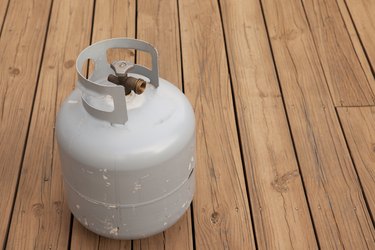 Most tanks don’t have gauges, but you can easily check how full it is. Image Credit: DonNichols/E+/GettyImages
Most tanks don’t have gauges, but you can easily check how full it is. Image Credit: DonNichols/E+/GettyImages


